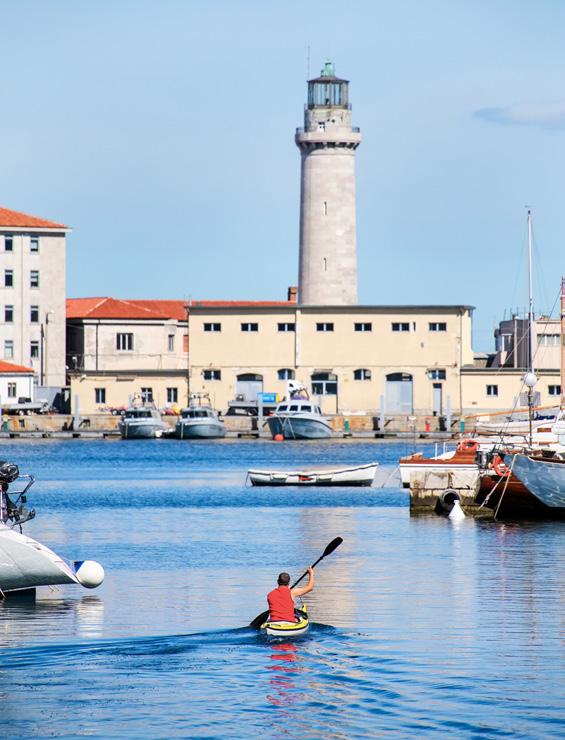
3 minute read
Il mare è dappertutto: basta solo saperlo cercare.
be swimming in the sea within the city.
In his La Méditerranée French historian Fernand Braudel observes that numerous food types considered part of the Mediterranean diet come from different worlds. For instance, you may be surprised to learn that tomatoes were unknown in certain areas at the edge of the Karst Plateau up until the early 20th century −although the first tomatoes had crossed the sea and reached these shores a few centuries earlier. Trieste was never able to change the sea– the Republic of Venice and the Royal Navy may have very well been the only ones to ever succeed in such endeavour. It was the sea that changed the course of the city’s history.
Advertisement
Every natural terrace, be it a stretch of ploughed land or a lookout spot, has a view of the sea. Halfway between coast and inland, an intricated web of roads and paths extends in every direction. Some are named after distinguished Italian citizens. Others, like Strada del Friuli or Via dell’Istria, are named after their destination. Via Revoltella, a long arterial road connecting the city centre to the suburbs, is dedicated to the memory of Baron Pasquale Revoltella, who, in the 19th century, on behalf of the Hapsburg Empire, purchased a number of shares in the company that would soon “pierce” the isthmus of Suez, thus favouring trade exchanges with the western world. It was a long, uphill journey: travelling East had never been an easy or predictable task.
There are itineraries following the routes of Karst fishermen: long stairways that served as Adriatic (and human) cart tracks still connect the Plateau to the sea today. There are names that appear more than once between the Karst shoulder and the coast: Bovedo, in the rione of Barcola, is the name of both a stream and a beautiful forest. Once known for its saltworks and brooks, the city-centre area called Piazza San Giovanni owes its name to the fact that Triestini used to gather here before setting off for the rione of the same name, where celebrations in honour of this Saint are held every summer. Once again, we move from sea to inland, from west to east. Trieste has many seas, and the right current is not always the one following the flow.
Val Rosandra, with its river and icy waterholes, is an inner sea – and a relief from the heat. Inside the natural reserve a dip in the water is allowed, if the heat is unbearable. The “sea within” could also refer to a lake – but there are no lakes in Trieste. There are rivers and streams –known as patok, Slovenian for “brook”– although it would be quite hard to follow their course from spring to mouth today. Walking through the woods of al Cacciatore, the Bacaruba trail runs upstream alongside the river Starebrech (known today as Farneto). It is no Adriatic, but there are nights when the scent of the sea reaches all the way up here.
Walking between the Karst and sea, the mind may recall departures and arrivals, failures and successes. At the end of the Great War, it was via sea, not land, that the Italian army entered Trieste. Ressel’s first tests on ship propellers were a fiasco, and so the Austrian Empire let the patent slip through their fingers and into the hands of the British, who really knew a thing or two about seafaring. Maximilian of Hapsburg fell in love with Miramare almost by chance, as he made landfall in the bay of Grignano to find shelter from a sudden storm – and certainly not because he was driven by the urgent need to build a castle for his Charlotte. The Karst riff offers a few incomparable views of the sunset. Sea stacks of marine limestone right above the city skyline, as the crow flies. It could be an osmiza in Via Commerciale, or the wind rose in Conconello; or a natural outlook point, like the one in Duino that was named after Tiziana Weiss, among the first women mountaineers to lead-climb an ascent of a 6-grade route. She died after a fall while ascending a route of the Pala group, the largest massif of the Dolomites. Today, Weiss rests in the little cemetery of Barcola, on the seafront. In Trieste, where the sea dwells within one’s very conscience, the Adriatic is often compared to the Alps, and vice versa. Possibly because here things have many names and different meanings, and they work –or at least used to work– even when people did not think so. The sea of Trieste –within or without– stirs and bewilders, but is also able to clarify inaccuracies and soothe the soul. It may spark envy, and it may heal the heart. It is everywhere – one only needs to know where to look.








